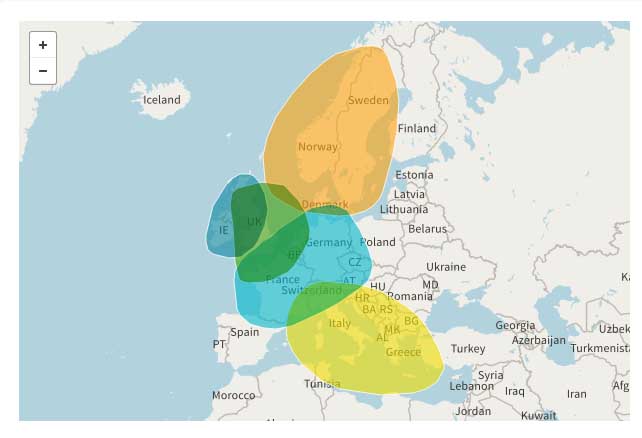Who Are You?
DNA
Odds are your ancestors travelled by sea or via extensive overland routes during the 1400s, 1500s, 1600s, etc. No matter where you live now, the chances are great that you are from elsewhere.
The Maritime Heritage Project, created in 1997, is a free research tool for those seeking history of passengers, ships, captains, merchants and merchandise sailing into California during the mid-to-late 1800s. The site illustrates the importance of a global awareness; the health and wealth of nations was and is formed by individuals who migrate seeking refuge and opportunity.
We recently had our DNA tested to determine just where we began. While we know about our Irish and German ancestors from the early 1800s-on, we had no information prior to 1830. Turns out It's fascinating.
Here's our map, which opened up new paths in our past: Celts, Vikings, Tunisia! Family research/stories included Germany, Ireland, England, and France. But nothing about other countries.
| Region | Approximate Amount |
EUROPE |
99% |
| Ireland | 43% |
| Europe West | 24% |
| Great Britain | 10% |
| Italy/Greece | 8% |
| Scandinavia | 6% |
| Trace Regions: European Jewish (4%), Iberian Peninsula (3%), Europe East (1%) | 8% |
WEST ASIA: Middle East |
<1% |

Do you know how far back you go and from where? 23 pairs of chromosomes define you.
AncestryDNA: Genetic Testing

This service combines advanced DNA science with the world’s largest online family history resource to predict your genetic ethnicity and help you find new family connections. It maps ethnicity going back multiple generations and provides insight into such possibilities as: what region of Europe are my ancestors from.
Find out what percent of your DNA comes from populations around the world, ranging from East Asia, Sub-Saharan Africa, Europe, and more. Break European ancestry down into distinct regions such as the British Isles, Scandinavia, Italy and Ashkenazi Jewish. People with mixed ancestry, African Americans, Latinos, and Native Americans also get a detailed breakdown.
Genealogy hobbyists liken the quest to track their family tree to a scavenger hunt, laden with clues, surprises and dead ends. For some, a snippet of genetic material has helped confirm a specific family tie or provide new leads when a paper trail has run cold. Others have blown up ancestral land mines along the way, shredding oft-repeated family stories or discovering a notorious distant relative.
Recently, scientists used the technology to confirm the identity of a skeleton buried beneath a parking lot in Leicester, England, as King Richard III, who died in battle in 1485. The scientists matched the bones to two living maternal-line relatives, according to the University of Leicester, which conducted the analysis along with radiocarbon dating and a skeletal exam.
“I think a lot of people find it of use to them, personally, especially if they are searching for a form of identity they are able to uncover in this way,” said Noah Rosenberg, associate professor at Stanford University’s Department of Biology and expert in evolutionary biology and genetics.
“Many people have a missing relative or have a parent die young and are searching for some kind of connection,” he said. “We see a significant trend where African-Americans are searching for some understanding of the populations from which their ancestors originated from Africa.”
As DNA is passed down from one generation to the next, some parts remain almost unchanged, while other parts change greatly. While it can’t provide you with your entire family tree or tell you who your ancestors are, DNA testing can:
- Determine if two people are related
- Determine if two people descend from the same ancestor
- Find out if you are related to others with the same surname
- Prove or disprove your family tree research
- Provide clues about your ethnic origin
It is now possible to map your global origins with the most complete coverage of your DNA through home DNA test kits which can be ordered through the mail or over the Internet.
They usually consist of a cheek swab or mouthwash to easily collect a sample of cells from the inside of your mouth. You send back the sample through the mail and within a month or two you receive the results – a series of numbers that represent key chemical “markers” within your DNA. These numbers are then compared to results from other individuals to help you determine your ancestry.









 Copyright ~ 1998-2018.
Copyright ~ 1998-2018. 